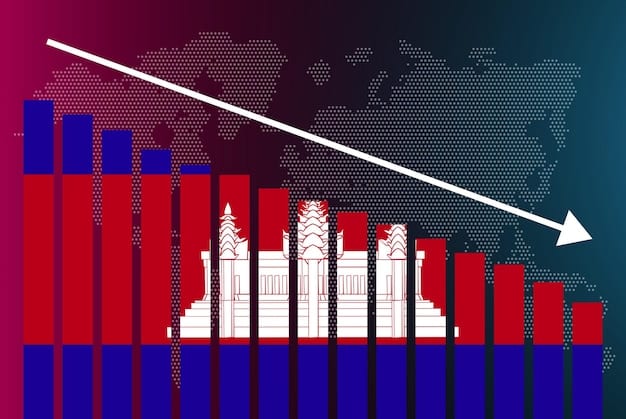The Future of Gun Control: Analyzing Proposed Reforms & Impacts

The future of gun control legislation in the US hinges on proposed reforms that aim to balance public safety with Second Amendment rights, sparking debates over their potential impacts on crime rates, civil liberties, and the overall effectiveness of reducing gun violence.
The debate around the future of gun control legislation: analyzing the potential impacts of the proposed reforms is one of the most polarizing and critical issues facing the United States today. Understanding these reforms requires a careful examination of their potential consequences and the complex balance between constitutional rights and public safety.
The Evolving Landscape of Gun Control Debates
The discourse surrounding gun control is constantly shifting, influenced by current events, evolving public opinion, and ongoing research. To understand the future, we need to trace the evolution of the debates.
Historical Context and Landmark Legislation
Gun control legislation in the US has a complex history marked by periods of stricter regulation and deregulation. Understanding this history is essential for grasping the current debates.
Several landmark legislations have shaped the landscape of gun control, influencing the current state of affairs.
- National Firearms Act (1934): Regulated machine guns and short-barreled firearms.
- Gun Control Act (1968): Established federal licensing requirements for firearms dealers and prohibited certain people from owning guns.
- Brady Handgun Violence Prevention Act (1993): Mandated federal background checks for firearm purchases
- Assault Weapons Ban (1994-2004): Prohibited certain semi-automatic firearms and large-capacity magazines for 10 years.
These pieces of legislation have had varying degrees of success and have faced numerous challenges, leading to further debate and reform efforts.
Understanding these moments in history helps provide context of how we got to this point.

Proposed Reforms: An Overview
Several reforms are currently on the table, each aiming to address different aspects of gun violence. Each proposal carries significant implications and potential impacts.
Universal Background Checks
One of the most widely discussed proposals is universal background checks. This would require all firearm sales, including those between private citizens, to go through the National Instant Criminal Background Check System (NICS).
Proponents argue that universal background checks would close loopholes that allow individuals prohibited from owning firearms to acquire them easily.
Assault Weapons Ban
Another prominent proposal is a renewed ban on assault weapons. Such a ban would prohibit the manufacture, sale, and possession of certain semi-automatic firearms and large-capacity magazines.
Supporters argue that these weapons are disproportionately used in mass shootings and have no legitimate sporting purpose.
Red Flag Laws
Red flag laws, also known as extreme risk protection orders (ERPOs), allow law enforcement or family members to petition a court to temporarily remove firearms from individuals deemed a threat to themselves or others.
These laws are seen as a way to prevent potential tragedies by temporarily disarming individuals in crisis.
These new proposals may be a sign of progress in the future.
Potential Impacts on Crime Rates
One of the central questions in the gun control debate is whether proposed reforms will lead to a reduction in crime rates. Understanding the relationship is very important.
The relationship between stricter gun control laws and crime rates is complex and multifaceted.
Studies on Gun Control and Crime
Numerous studies have sought to determine the impact of gun control laws on crime rates. Conclusions vary based on methodology, data sets, and the specific laws being examined.
Some studies suggest that stricter gun control laws are associated with lower rates of gun violence and overall crime.
It is challenging to establish a causal relationship between gun control laws and crime rates due to the many complex and everchanging factors that contribute to crime.

The Second Amendment and Civil Liberties
The Second Amendment is a cornerstone of the gun control debate, guaranteeing the right of the people to keep and bear arms. Finding common ground has come to be a very hard task.
Interpreting the Second Amendment
The interpretation of the Second Amendment has been a subject of intense legal and academic debate. The Supreme Court has weighed in on several key cases, attempting to clarify the scope of the right to bear arms.
The debate centers on whether the Second Amendment protects an individual’s right to own firearms for any purpose or if it is limited to militia-related purposes.
Balancing Rights and Regulations
- Reasonable Restrictions: Courts have generally upheld reasonable restrictions on gun ownership, such as background checks and restrictions on certain types of firearms.
- Infringement Concerns: Opponents of stricter gun control laws argue that they infringe upon the Second Amendment rights of law-abiding citizens.
- The Right to Self-Defense: Many argue that firearms are essential for self-defense, particularly in areas with high crime rates.
Balancing these competing interests is a difficult task that requires careful consideration of potential impacts on civil liberties.
The Role of Mental Health
Mental health is often cited as a contributing factor to gun violence. Understanding the relationship between mental health and gun violance is very important
Addressing Mental Health Issues
Many argue that addressing mental health issues is a crucial component of reducing gun violence. This includes improving access to mental healthcare, reducing stigma, and implementing early intervention programs.
Mental health professionals emphasize that the vast majority of individuals with mental illness are not violent and are more likely to be victims of violence than perpetrators.
Due Process Concerns
Proposals to restrict firearm ownership based on mental health concerns must carefully balance public safety with due process protections. Individuals should have the opportunity to challenge restrictions and demonstrate that they do not pose a threat.
These issues are very important to any changes to restrictions on gun ownership.
The Future of Gun Control: A Path Forward
The future of gun control in the United States will depend on the ability of policymakers to find common ground and craft effective legislation. We all hope for a better future,.
Comprehensive Approaches
Comprehensive approaches that combine stricter gun control laws with efforts to address mental health, poverty, and other root causes of violence may be the most effective.
Such approaches recognize that gun violence is a complex problem with no single solution.
Bipartisan Collaboration
Bipartisan collaboration is essential for achieving meaningful progress on gun control. Finding areas of agreement and working together can help overcome the political gridlock that has stymied reform efforts in the past.
This may require compromising on certain issues and focusing on solutions that have broad support.
| Key Point | Brief Description |
|---|---|
| ⚖️ Second Amendment | Guarantees the right to bear arms; interpretation is key. |
| 🏥 Mental Health | Plays a role; access to care and addressing stigma is important. |
| 🤝 Bipartisan Collaboration | Essential for achieving meaningful progress |
| 🔍 Universal Background Checks | Aims to close loopholes in firearm sales. |
FAQ Section
▼
Red flag laws, or extreme risk protection orders (ERPOs), authorize courts to temporarily remove firearms from individuals deemed dangerous to themselves or others based on petitions from law enforcement or family members.
▼
While mental health is often cited, it’s important to know that the vast majority of individuals with mental illness aren’t violent. The focus is on improving access to mental healthcare and reducing stigma.
▼
The Second Amendment guarantees the right to keep and bear arms, but it’s been subject to various interpretations. The Supreme Court weighs in regularly, and provides clarification for the right to bear arms.
▼
Universal background checks require all firearm sales, including private transactions, to go through NICS. Proponents argue it closes loopholes for those prohibited from owning guns.
▼
An assault weapons ban would prohibit the manufacture, sale, and possession of certain semi-automatic firearms and large-capacity magazines. It has led to very intense debates over the purpose of these weapons.
Conclusion
Ultimately, the future of gun control legislation hinges on finding a balance between Second Amendment rights and public safety. Comprehensive approaches, bipartisan collaboration, and evidence-based policies are essential for creating a safer and more secure society for all.





